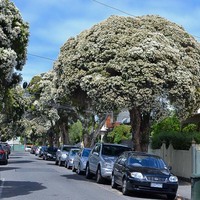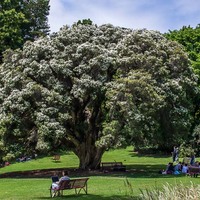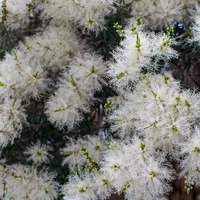Common name: Snow in summer
Other common names: Flaxleaf paperbark, Honey myrtle, Narrowleaf paperbark, Narrowleaf teatree
Description
Snow in summer is a flowering and essential-oil yielding tree originating in Australia, its native range extending across warm-temperate and subtropical areas in the east of the continent, where it occurs in pockets of coastal forests. It prefers swampy, poorly drained sites or sites subject to flooding or that turn into watercourses during the rainy season.
On favourable sites, it is moderately fast-growing and reaches heights of up to 15 m (50 ft). However, it is more commonly 5 to 10 m (16 to 32 ft) tall and develops a stout, occasionally forked trunk supporting a densely branched rounded crown. The bark is off-white to cream coloured and sheds in papery sheets that persist on the trunk, forming layers of dry, dead bark that can be peeled off by hand.
The leaves are very small, lance-shaped, dull blue-green and closely arranged along thin branchlets, themselves packed tightly in the crown, casting a deep shade on the ground below. They remain on the tree throughout the year and, when crushed, release a camphorous aroma.
In spring, spikes of fluffy white flowers with the appearance of snowflakes cover the crown, almost completely hiding the foliage from view. They are followed by small, woody, cup-shaped seed capsules closely spaced along the branchlets, becoming dry and light brown when mature with many tiny seed inside.
Use
Snow in summer is cultivated in gardens, parks and as a street tree for its showy flowering, shapely form, unusual and interesting bark and the shade it provides.
The leaves on steam distillation yield commercial quantities of 'Tea tree oil', though they are not as heavily exploited as the leaves of Melaleuca alternifolia, the principal source of the oil. Tea tree oil is a colourless to pale yellow oil extracted mainly for medicinal use as an antiseptic, antibacterial and antifungal agent. Oil yields range from 1 to 2% of the leaves by weight, depending on the proportion of old- to new-growth in the distilled material. Snow in summer oil is similar to Tea tree oil from Melaleuca alternifolia, but is more Eucalyptus-like in its aroma and flavour.
The wood is hard and durable under water, making it suitable for submerged pilings on swampy ground or in water. If properly dried, it makes reasonable firewood.
The peeled bark makes excellent kindling or fire-starting material, and Indigenous Australians have long used it for this purpose.
Honeybees actively visit the flowers as a source of nectar and pollen. Still, both are produced in only moderate amounts. The small amount of honey produced is dark amber and strongly flavoured.
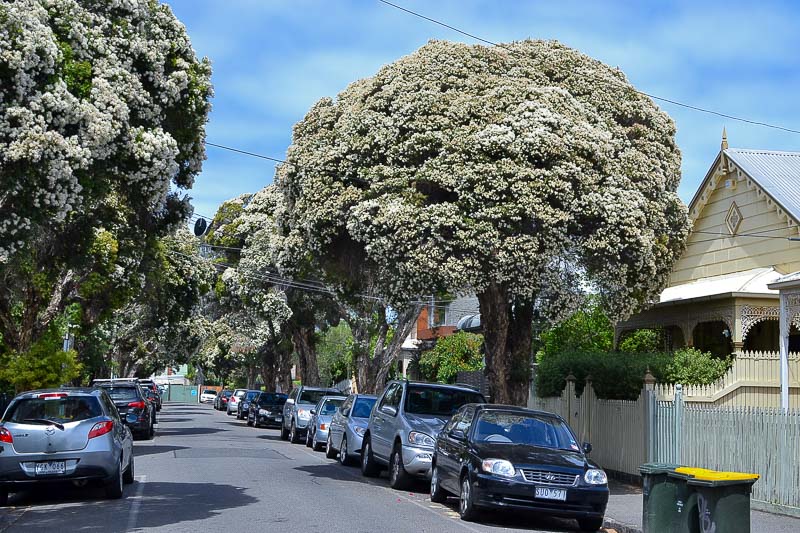
Trees in full bloom (Melbourne, Australia)
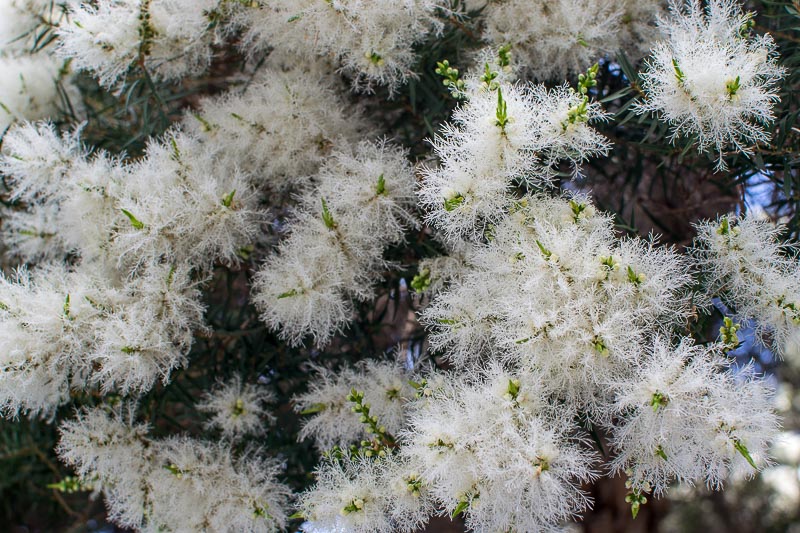
The flowers remind of snowflakes
Health use
Tea tree oil has natural antiseptic, antibacterial and antifungal properties. It is applied topically to insect bites and stings, wounds, burns, acne, warts, athlete's foot, vaginal yeast infections and oral infections, including gum ailments. It is also used in inhalation treatments against coughs, colds and flu.
The thin, papery layers that make up the bark sandwich a fine powder that is reportedly a natural antibiotic and have been used for centuries by Aboriginal Australians as a bandage in wound healing.
Climate
Grows naturally in moderately humid warm-temperate to subtropical climates, generally areas with annual lows of 6 to 17°C, annual highs of 18 to 30°C, annual rainfall of 500 to 2000 mm and a dry season of 6 months or less, extending to 12 months with irrigation or groundwater.
Growing
New plants are usually started from seed. Performs best on slow- to free-draining clay-loam, loam, sandy-loam and loamy-sand soils of a moderately acid to neutral nature, generally with a pH of 5.0 to 7.5, and on sites with full to partial sun exposure.
Snow in summer is moderately salt tolerant, with its growth reportedly unaffected by soil-salt conditions equivalent to up to 3.0 grams of dissolved salt per litre of water, about one-twelfth that of seawater concentration.
Problem features
It is listed as a weed in at least one publication. Still, there does not appear to be any record of it becoming naturalised or a serious weed anywhere outside of Australia, despite its introduction and cultivation in Florida, Louisiana, California and other non-native regions.
The roots are moderately invasive, and a minimum planting distance of 4 m (13 ft) from any underground pipes is recommended.
Where it grows
References
Books
-
Barwick, M., et al. 2004, Tropical & subtropical trees : a worldwide encyclopaedic guide, Thames and Hudson, London
-
Blake, S. T. & Roff, C. 1987, The honey flora of Queensland, 3rd ed., Queensland Department of Primary Industries (QLD DPI), Brisbane
-
Chevallier, A. 2000, Encyclopedia of herbal medicine, 2nd American ed., Dorling Kindersley, New York
-
Clemson, A. 1985, Honey and pollen flora, New South Wales Department of Agriculture, Inkata Press, Melbourne
-
Guenther, E. & Althausen, D. 1948 to 1952, The essential oils (6 volumes), Van Nostrand Publishing, New York
-
Holliday, I. 2002, A field guide to Australian trees, 3rd revised editon, New Holland Publishers, Frenchs Forest, New South Wales
-
Leech, M. 2013, Bee Friendly: A planting guide for European honeybees and Australian native pollinators, Rural Industries Research and Development Corporation (RIRDC), Canberra, Australian Capital Territory
-
Marcar, N. E. 1995, Trees for saltland : a guide to selecting native species for Australia, Division of Forestry, Commonwealth Scientific and Industrial Research Organisation (CSIRO) Australia, Canberra
-
Menninger, E. A. 1962, Flowering trees of the world for tropics and warm climates, 1st ed., Heathside Press, New York
-
Oakman, H. 1995, Harry Oakman's what flowers when : the complete guide to flowering times in tropical and subtropical gardens, University of Queensland Press, St. Lucia, Queensland
-
Perry, B. 2010, Landscape plants for California gardens: an illustrated reference of plants for California landscapes, Land Design Publishing, Claremont, California
-
Randall, R. P. 2002, A global compendium of weeds, R.G. and F.J. Richardson Press, Melbourne
-
Randall, R. P. 2007, The introduced flora of Australia and its weed status, Cooperative Research Centre for Australian Weed Management, Glen Osmond, South Australia
-
Weiss, E. A. 1997, Essential oil crops, CABI Publishing, Wallingford, Oxfordshire
